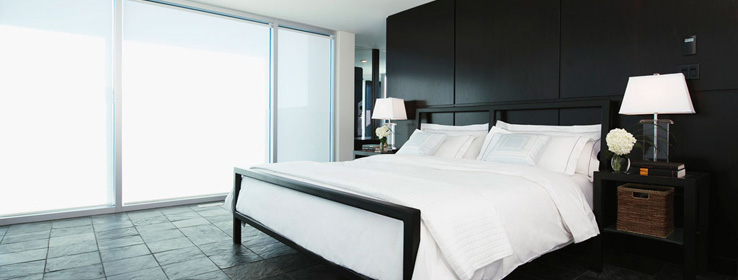Amy Devers of Trading Spaces offers her tips for pulling off bold, beautiful black walls.
Black is no stranger to the world of interior design. It adorns sofas, desks, entertainment centers, tables and accessories. But consumers willing to take a little risk with their interior design are starting to use black in larger swaths – particularly walls – with bold, stylish results.
"Black walls are very current right now, but I think a lot of people shy away from them because they have this sort of macabre reputation," says Amy Devers, a carpenter on The Learning Channel's Trading Spaces. "But depending on how you do it, it really doesn't have to be that way at all. Ultimately, black is always chic, and though it's dark, it is a neutral and goes with everything."
Think of a black wall as the equivalent of the little black dress: It takes many forms and can really shine when paired with the proper accessories. Devers offers her tips for successfully dressing up – and pulling off – the black wall in any room.
Start small. As any prudent designer knows, suggesting small doses of change to wary clients is a smart strategy that can have far-reaching effects. For example, the bathroom may be the perfect place to branch out with black. "The mirrors and typically chrome fixtures that are already in there really pop against the black and create a dynamic environment," Devers notes, adding that fireplace surrounds, built-in shelves, trim, and window and door casings are also good places to experiment with black paint.
Think patterns and texture. Consider painting a wall a flat black, then covering it with a sheen in the form of a graphic repeating pattern. Devers suggests vintage floral or geometric '80s pop art patterns. "The sheen change is very subtle and elegant," she says.
Treat the wall like a piece of artwork. "I like the idea of painting one whole wall black and then framing it with profile molding painted in a gloss black," Devers says. "It's like a giant picture frame on one wall." She also recommends buying pre-stretched blank canvases or fence boards, painting them black, and hanging them on a wall covered in black flat paint. "You now have a relief that catches the light, creates some shadow and gives the wall texture and merit," she says.
Experiment with gradation. "If you have a large, well-lit room, particularly one with high ceilings, paint the walls black up to about eye level, switch to a gray up to the ceiling, then finish off the room with a white ceiling," Devers says. "The black anchors the wall while the gray creates the impression that the room is opening up to a white sky. The effect is stunning. When used on one wall or two adjacent walls in a smaller room, it can really make the room seem much bigger, and the gradation is very uplifting."
Pick the right lighting and accessories. Picking the right type of lighting for a black wall is important, since it will absorb light. "Track lighting can work well because you can angle the lights to hit the dark spots," Devers says. She also likes to use big, bold light fixtures in tandem with black walls. Her choices: opulent chandeliers (vintage ones look particularly beautiful, she notes) and pendant lights with mini bulbs. Also, consider using high-gloss paint rather than a flat or eggshell finish, because glossy paint reflects light, multiplying it and adding sparkle to the room. From an accessories standpoint, go for pops of color against the black. Devers identifies butter cream and greens as popular accent hues against black walls, because their very neutrality provides a great backdrop to experiment with a wide array of additional colors within the room.










